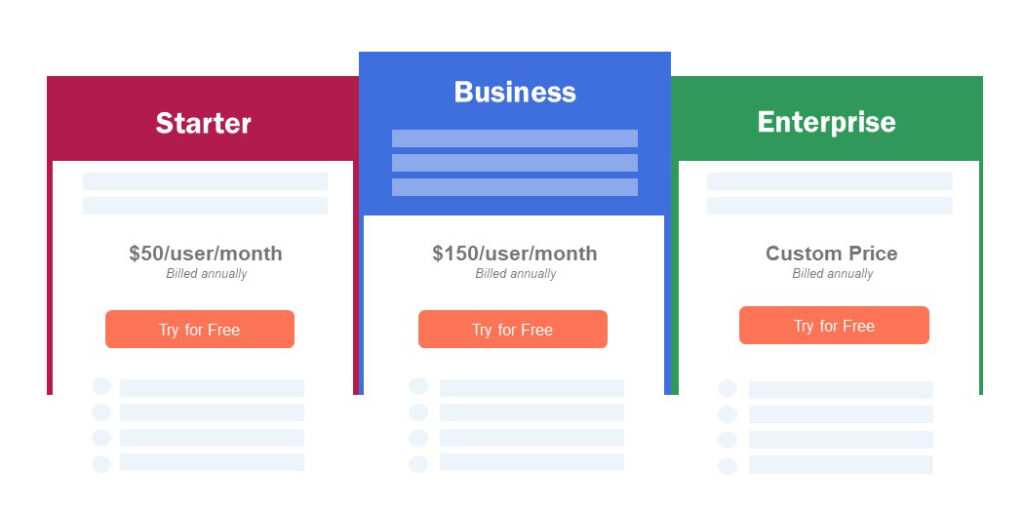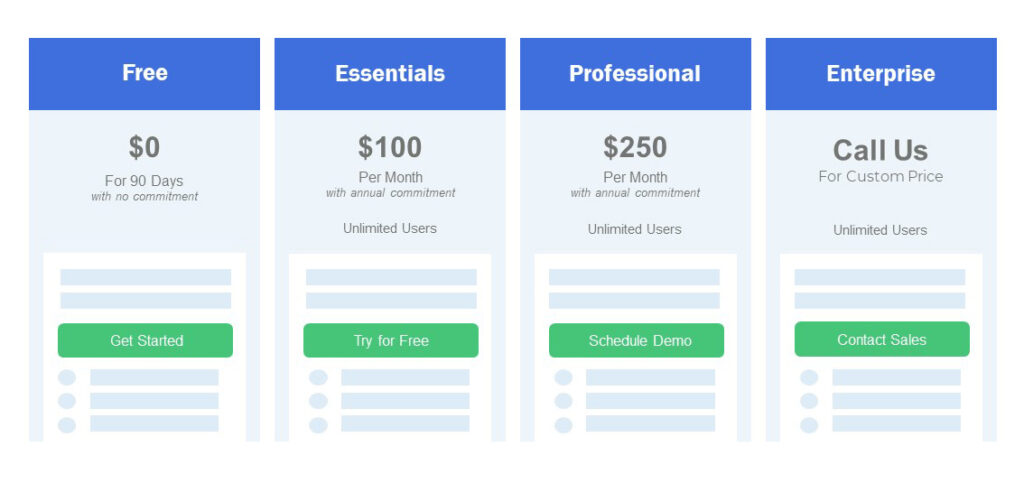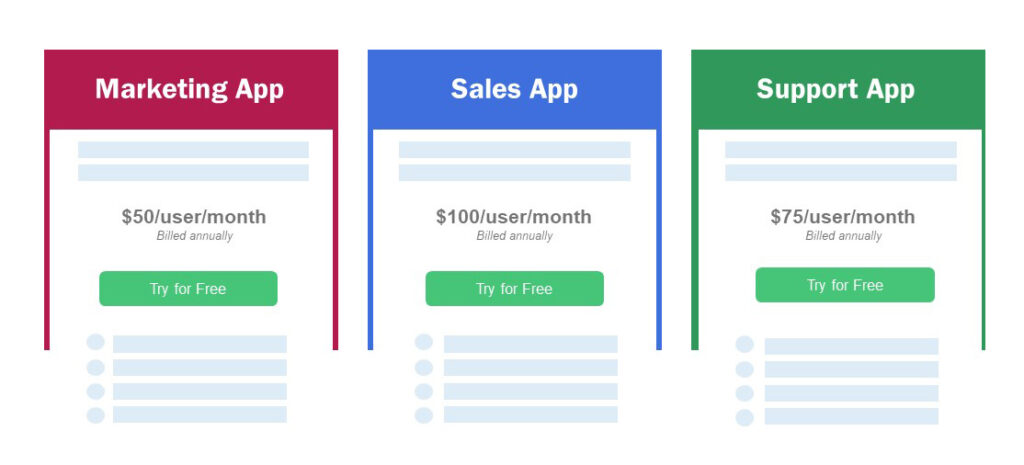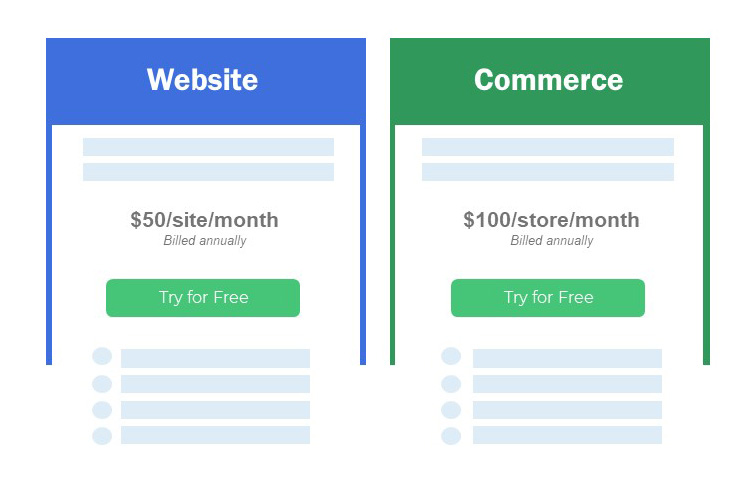Cloud and SaaS pricing is typically multi-dimensional, meaning that there are two (or more) different variables that drive the monthly price. The first dimension is typically the number of features available for the customer to use. Most cloud and SaaS applications are packaged into multi-tiered offerings. Each tier offers more features along with a higher price. The second (and possibly third/fourth) dimension(s) is typically a value metric that correlates to the customer’s actual interaction with the product. The value metrics typically fall into four categories: 1) number of users, 2) quantity of consumption, 3) monetary value processed, or 4) alternative application specific metric.

Why use Multiple Dimensions?
- More seats contracted in a per user per month model
- More seats consumed in a usage-based pricing model
- More dollars of transactions processed in a percentage model
Additionally, as the customer becomes more dependent upon the products, their needs will evolve and the desire to obtain a more fully-featured version of the product will increase. As a result, the customer will want to upgrade from the lowest tier to a the medium tier and then from the medium tier to the highest tier, each of which has a higher monthly price point.

The First Dimension of SaaS and Cloud Pricing Models
Features
Almost every cloud and SaaS provider packages their product features into multiple tiers at multiple different price points. Depending upon the product, there may be two, three, four or more different tiers. Four tiers is the most common. The bottom tier is typically “free” followed by three paid tiers that progressively increase the value to the customer. Think “good,” “better,” and “best.”
- Tier 1 ($0) – Free and a limited mix of functionality that includes 10 of the 50 features
- Tier 2 ($100/mo) – Paid with entry point pricing and a “good” mix of functionality that includes 25 of the 50 features
- Tier 3 ($250/mo) – Paid with higher pricing and a “great” mix of functionality that includes 35 of the 50 features
- Tier 4 ($500/mo) – Paid with highest pricing and the “best” mix of functionality that includes all 50 features.
You have, undoubtedly, seen these tiered models illustrated on pricing pages all over the web. Often, the highest tier does not have a price listed on the public website, but instead has a call-to-action to request pricing. SaaS and cloud providers will typically negotiate pricing for the highest tier uniquely for each customer during a sales cycle.
Example of Multi-Tiered Feature Packages for SaaS/Cloud

The Second Dimension of SaaS and Cloud Pricing Models
Value Metrics
There are four types of value metrics that are typically used for cloud and SaaS pricing. Some are agreed upon during the sales process and only change with a formal contract modification. These include the per user (#1) and application-specific (#4). Other types of value metrics, the consumption (#2) and percentage (#3) models, are based upon the customer’s actual usage of the product and are metered to determine the amount billed each month.
Note, that some are agreed upon during the sales process and only change with a formal contract modification. These include the per user (#1) and application-specific (#4). Other types of value metrics, the consumption (#2) and percentage (#3) models, are based upon the customer’s actual usage of the product and are metered to determine the amount billed each month.
Type 1: Per User Pricing
By far the most popular approach to pricing SaaS applications is to charge per user per month. Most CRM and ERP vendors that offer sales, marketing, operations, customer service, finance, accounting, and human resources applications charge a per user per month fee. Corporate communications and productivity vendors also charge per user per month for apps such as word processing, spreadsheets, presentations, project management, email, video conferencing, chat and collaboration also charge per user.
Example of Per User Per Month Pricing

Examples of B2B User Pricing
- CRM applications such as Salesforce.com might charge a fee for each registered user creating leads, accounts, or opportunities.
- Productivity applications such as Monday might charge a fee for each team member collaborating on projects or workflows.
- Customer support applications such as Zendesk might charge a fee for each registered user on the technical support team.
- Online office applications such as Microsoft 365 might charge a fee for each user creating spreadsheets, presentations, or documents.
- Collaboration applications such as Slack might charge a fee for each user active in the company’s channels.
- Video conferencing applications such as Zoom might charge a fee for each user scheduling online meetings.
Example B2B Pricing – Salesforce.com Sales Cloud Pricing

B2C User Pricing
Per user per month models are not as common in the B2C sector. Most consumers applications are designed for a single user so there is just a price per month. Some consumer applications offer family plans with shared access to data and features. For example, streaming media services such as Spotify specify the number of users that can share the same subscription plan.

Type 2: Usage-Based Pricing Models
A second approach is to base pricing upon actual consumption, or what is called “usage-based pricing.” Most cloud-based compute, storage, database, IoT, media, and AI/ML services price based upon units of consumption. There are a few different flavors of usage-based pricing that each have different approaches to metering. The value metric could be the number of transactions processed each month, the number of records in a database, the amount of time a resourced is utilized, or the volume of consumption that occurs during a month.
Example of Usage-Based Pricing for Cloud Services

Examples of B2B Usage-Based Pricing
- Fraud – An online fraud detection vendor such as Sift might charge on a per-transaction basis to verify each consume opening a bank account.
- Cloud Infrastructure – A cloud computing vendor such as Amazon.com might charge on a per-hour basis to rent access to compute and storage services.
- Edge Computing – A content distribution network such as Fastly might charge on a per GB basis for the egress of data transfer out of the customer’s environment.
- Marketing Automation – A marketing automation vendor such as Hubspot might charge on a per-record basis correlated with the number of contacts in the database.
- Cloud Monitoring – An infrastructure health and performance monitoring provider such as DataDog might charge based upon the number of hosts monitored.
- Email Marketing – An email service provider such as Mailchimp might charge based upon the number of email messages sent.
- Customer Support – A customer communications service such as Twilio might charge based upon the number of SMS/text messages sent.
- Shipping – An e-commerce shipping software vendor such as Shippo might charge based upon the number of labels printed.
B2B Usage-Based Pricing
- Ride sharing services such as Uber and Lyft priced based upon the time and distance of the trip
- Electric vehicle charging stations charge per minute or hour for access to the grid.
- Bike share and electric scooter rental programs charge a per minute fee for rentals.
- Usage-based insurance policies charge per mile driven or based upon multiple variables collected related to driver behavior.
Type 3: Percentage Pricing Models
A third popular SaaS and cloud pricing approach is the percentage model, in which the customer is charged a small percentage of the dollar value of the transactions passed through an application. An alternative way to think about percentage is commission. Percentage pricing is popular amongst providers in the e-commerce, fintech, online travel, and marketplace segments. The percentage taken can range from a fraction of a percentage (e.g. 0.2%) to a few points (2%).
Example of Percentage Pricing for Fintech

Examples of B2B Usage-Based Pricing
- Retail point of sale vendors such as Toast might charge a fee based on the percentage of the merchandise value processed through their terminals.
- E-commerce vendors such as Shopify might add a surcharge for each card transaction on their platform based on the percentage of the dollar value.
- Talent marketplace vendors such as Upwork might charge a fee based on the percentage of a freelancer/consultant’s billing per month.
- Payment gateways such as Stripe might charge a fee based on percentage of the dollar value of credit and debit card transactions processed.
- Online events platforms such as Hopin might charge a fee based on percentage of the dollar value of ticket prices purchased.
- Billing vendors such as Chargebee might charge a fee based on the percentage of the revenue invoiced through the platform.
- Digital ad agencies might charge a fee based on the percentage of the dollar value of Facebook and Google ad spend managed by their platforms.
- Many SaaS and cloud vendors price technical support as a percentage of their own monthly recurring fees for other products.
B2C Percentage Pricing
- Esty, eBay, and Amazon.com each charge a percentage of the dollar value of the sale price of peer-to-peer sale transactions occurring on their marketplaces.
- Doordash, UberEats, and Grubhub each charge a percentage of the dollar value of orders delivered through their networks from the restaurants supplying the food.
- PayPal, Square, and Apple Pay each take a percentage of the dollar value of transactions processed as a fee to the merchant (business).
- Expedia, Kayak, Priceline.com each take a percentage of the dollar value of bookings reserved on their platform from the airline, hotel chain, or rental car operator.
Type 4: Application-Specific Vendor Metrics
The least common and fourth approach that cloud and SaaS providers take to pricing is an application specific value metric. The model is similar to the per user per month approach, except that instead of user count, an alternative metric specific to the industry or domain is chosen. For example, an IoT company might charge based upon the number of endpoints connected to its service. The application specific model is very similar to the consumption model with the key difference being that the quantity is usually agreed upon in advance. Unlike the consumption model which meters usage and calculates pricing in arrears, the customer and vendor agree upon a fixed number of units that form the basis of pricing and it is listed in the sales order.
Example of Application-Specific Value Metrics for Website Hosting

Examples of B2B Application-Specific Value Metrics
- Retail point of sale vendors such as Toast might charge a fee based on the percentage of the merchandise value processed through their terminals.
- E-commerce vendors such as Shopify might add a surcharge for each card transaction on their platform based on the percentage of the dollar value.
- Talent marketplace vendors such as Upwork might charge a fee based on the percentage of a freelancer/consultant’s billing per month.
- Payment gateways such as Stripe might charge a fee based on percentage of the dollar value of credit and debit card transactions processed.
- Online events platforms such as Hopin might charge a fee based on percentage of the dollar value of ticket prices purchased.
- Billing vendors such as Chargebee might charge a fee based on the percentage of the revenue invoiced through the platform.
- Digital ad agencies might charge a fee based on the percentage of the dollar value of Facebook and Google ad spend managed by their platforms.
- Many SaaS and cloud vendors price technical support as a percentage of their own monthly recurring fees for other products.
B2B Examples of Application-Specific Value Metrics
- Marketing intelligence vendors might charge based upon the number of leads provided.
- Hospitality industry applications might charge based upon the number of rooms in the hotel.
- Healthcare industry might charge based upon the number of beds in a hospital.
- Retail industry applications might charge based upon the number of point-of-sale terminals.
- Real estate industry applications might charge based upon the number of property locations that are being administered by the software.
- Human Resources might charge based upon the number of employees in the organization being supported by the application.
- Cybersecurity company might charge based upon the number of endpoint devices being actively managed by the security operations center.
- A web hosting company such as WP-Engine might charge based upon the number of sites or domains hosted.
Some companies define their own custom units of measure. For example, Zapier charges based upon the number of tasks processed.









